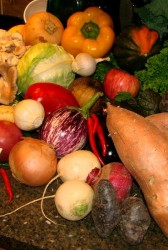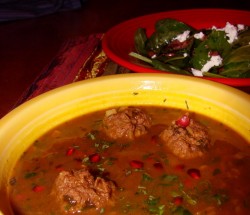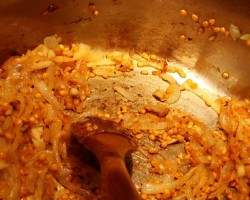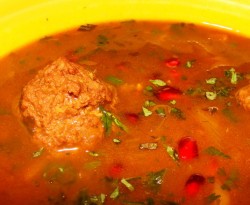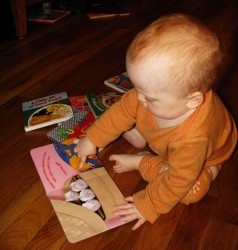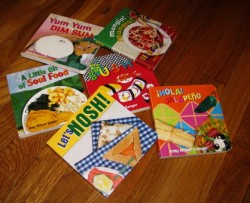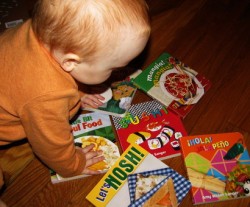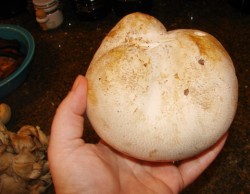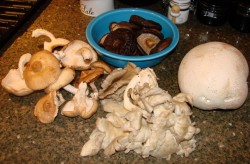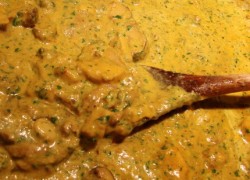Almost Vegetarian, Vegetarian and Vegan Archives Finished
The work of going through all of my nearly three years worth of posts and adding the relevant ones to the newly created “Recipes: Almost Vegetarian, Vegetarian and Vegan” category is finished. The archives are duly cataloged, and it should be simpler for those looking for straight up vegetarian or vegan recipes or non-vegetarian recipes that can be easily adapted to a vegetarian lifestyle to find what they want.
I realized as I looked at the finished categories that I actually had more vegetarian or vegetarian friendly recipes than I thought I did. In fact, this category contains more recipes than any other single category on this blog.
I really think it was worthwhile for me to go through my archives like this, not only because I made them easier for readers to search, but also because I noticed quite a few trends in my cooking and writing interests.
First of all–I bake a lot of pies and cookies, but not many cakes. That is in large part because while I like cake, I like pie better, as do both Zak and Morganna. And cookies–well, they were the first of my specialties–I used to play at making them as a toddler, and by the time I was fourteen I was in charge of the Christmas cookie baking in my parents’ house.
Besides, cookies are fun.
I also noticed that I have a lot of baking recipes in general, but not much in the way of yeast bread recipes. Which is weird, because I love to bake bread–I just haven’t done much bread baking in about three years, in large part because I have lived near good bakeries all through the time I have been writing this blog. So–well, there we are. I learned that if I don’t have to bake bread to have good bread, I won’t bake it. I will buy it instead and support my local bakers.
I also seem to like to make breakfast foods. There are recipes for pancakes, French toast, scones, German baked pancakes and waffles on my blog. I feel like I should have a breakfast food category. But then, I would have to go through the entire blog again, which might become a mite bit tiresome.
I have done a lot of bean recipes, but not nearly as many as I would like. That is because while Morganna and Kat and I could eat beans until the world ends, Zak is not as fond of them as we are. So, that slows us down a little bit in the bean department.
And there are not as many soup recipes as there ought to be. I love soup, but Zak is seldom content to eat soup as a meal. It is part of a meal in his universe. This is a drag for me, because I grew up with soup being a great one dish meal, meant to be filling and delicious.
Oh, well. I will have to make more soups, anyway, because at work, we are going to have a soup of the day from now on. Granted, another cook, Dennis, is in charge of the soup, but I will still probably be making some of them. (We joked about turning Dennis into “Salaam’s Soup Nazi,” but I think he is too soft-spoken and nice to really hold that title. We’ll have to come up with a better one for him that suits his personality better.)
So, what does the future hold for this category?
Well, I think that I will be doing some more bean and lentil dishes, certainly, because I am very fond of them. And, maybe some more tofu, as I love it as well. Seitan, too, perhaps, but absolutely no tempeh. I cannot stand the smell of it or the flavor–I think it is because I am allergic to many kinds of molds, and mold is part of what makes tempeh, well, tempeh.
There will likely be more vegan recipes–in large part, because I do cook so many Asian foods–but there will likely not be any vegan baked goods.
This is because I have never had a truly wonderful vegan baked good. I have had some which were acceptable or not bad, but I don;t see any reason to post recipes that are only acceptable or not bad here. I will only share the best stuff here. I am stubborn that way. I see no reason to promote cardboardy cookies, overly chewy cakes or gummy, heavy muffins here. Now, if I -do- find vegan baking recipes that turn out stuff that is just as good as the butter and egg filled usual suspects, I will certainly share them, and gladly.
But, really, I have eaten (and baked–for vegan clients) a lot of vegan cookies, brownies, pies, cakes and muffins, and I have yet to truly embrace any of them.
For me, butter and eggs are inseparable from the concept of excellent baking.
I don’t know what all else, but if anyone has any requests or ideas, do not hesitate to share them with me, and I will see what I can do to help you.
Oh–one more thing–someone asked if I could have a clickable list of whatever recipes are in each category when you click on the category.
Well, I can ask my in-house-techie, but I suspect the answer is at least going to be “No the now.”
In other words, “Not yet.”
With the implied, “Maybe never, because I have no idea how to code such a thing.”
Besides, he is working on the priority of updating the software and installing a plug in that allows readers to have a printer-friendly version of a post ocme up–that way you can print out my recipes and take them into the kitchen without a bunch of excess crap being printed out and wasting huge amounts of your paper.
No need to kill extra trees all in the name of some recipes from my blog.
Persian Pomegranate Soup: Ash-e Anar
Pomegranates, when they are properly ripe, are a revelation of sweet aroma and tart flavor.
The tiny shimmering garnet fruits burst in the mouth, shooting sweet juices tinged with a sour aftertaste, with the barest hint of bitterness from the seed within.
I grew up eating one or two pomegranates a year, as treats. My father introduced me to them–he had eaten them very rarely as a child, and he remembered them as the most amazing fruit imaginable. I grew up eating them raw, and out of hand, carefully tearing away the leathery burgundy rind, and picking the seeds away from the flavorless pith, popping them into my mouth one by one, the juice staining my fingers first pink, then violet, and finally, black, as the juice oxidized in the beds of my fingernails, and cuticles.
It never occurred to me to cook with them until I began reading about the foods of Persia, now called Iran.
The Persians use a great deal of pomegranate fruit in their foods, either as the fresh fruit itself, or in the form of dried pomegranate seeds, or in the form of their juice, boiled down into a viscous dark liquid that is both as strongly sweet and fragrant as honey, and as sour as lemons–known as pomegranate molasses.
Pomegranates are used in both sweet and savory dishes throughout the Arab world, but I have found some of the most decadently delicious dishes in the cuisine of Persia–including this recipe for pomegranate soup, which, after I adapted it and played with it, may become a staple soup in my repertoire.
It begins with a strong flavor base from well-browned onions and garlic cooked in olive oil. Yellow split peas are added and cooked to a pale brown, before a large amount of chicken broth or stock (or, if you wanted to make this vegetarian, vegetable broth) is poured into the pot.
Then, come the spices, including black pepper, turmeric, a stick of cinnamon, and about a teaspoon of Aleppo pepper.
Meatballs made of lamb, minced garlic, minced onion and fresh herbs, are added, along with some basmati rice, and pomegranate molasses, before the soup is allowed to simmer. The pomegranate molasses gives the soup a deep brownish red coloring, and the spices give it an incredible fragrance.
Right before serving, fresh mint, cilantro, parsley and chives are stirred in, along with a small amount of heavy cream–a completely inauthentic addition which helps round out the flavors and soften the tartness of the pomegranate. About a cup or so of fresh pomegranate seeds go in as well to give bursts of color and flavor to the finished dish.
The resulting soup is both hearty and delicate: it is quite filling with the split peas, rice and meatballs, but the flavors are painterly, with subtle strokes of spice, kisses of sweetness from the fruit and a deep richness from the meatballs.
(The meatballs could be replaced with mushrooms for a vegetarian version–for a vegan version, leave out the cream altogether or replace it with a small amount of almond milk or coconut cream.)
This would make a good light supper with a hearty salad of mixed greens, fresh spinach, goat cheese, nuts and fruits.
Ingredients:
4 tablespoons olive oil
3 large onions, peeled and thinly sliced
6 large cloves garlic, minced
3/4 cup yellow split peas
2 quarts chicken or vegetable stock
2 teaspoons freshly ground pepper to taste
1 tablespoon Aleppo pepper
1 tablespoon ground turmeric
1 cinnamon stick
1/4 teaspoon ground fennel seed
1 pound lean ground lamb
1 tablespoon finely minced garlic
1/4 cup finely minced onion
1/4 cup freshly minced fresh herbs–a mixture of cilantro, mint, and parsley
1 cup basmati rice
1/4 cup pomegranate molasses
1 tablespoon sugar or honey
1/4-1/2 cup heavy cream–optional
3 cups fresh pomegranate seeds
1 cup mixed fresh herbs, minced–use at least two of the following: chives, cilantro, mint and parsley
salt, to taste
Method:
Heat olive oil in the bottom of a heavy stockpot, and saute onions until they turn golden brown. Add garlic, and continue stirring and cooking until the onions are well browned, the garlic is golden, and everything is fragrant. Add the split peas, and continue cooking until the peas take on a bit of color, about a minute or so longer.
Add the stock and the spices, and bring to a boil, then turn down the heat and simmer until the peas are tender.
Mix together the lamb, minced garlic, onion and herbs until well blended, and form into walnut sized balls.
Drop the meatballs and rice into the soup, and add the pomegranate molasses, and sugar or honey. Cook until the rice, split peas and meatballs are cooked. Stir in the optional cream if you are using it, along with the fresh pomegranate seeds and fresh herbs.
Add salt to taste, and if needed, correct seasoning. Fish out cinnamon stick before serving.
The Literary Approach to Raising a Little Foodie: The Books of Amy Wilson Sanger
I know that quite a few of you don’t have babies or children of your own.
But you may well have nieces or nephews, or a number of friends who have decided to procreate, or heck, maybe even a neighbor or co-worker is about to have a baby.
What is the perfect gift for a foodie to give to a baby in order to open new eyes to the world of food?
Well, other than a ringside seat in the kitchen with the highchair pulled near the stove so that the scents, sights and sounds of cooking enter their consciousness from day one? And other than a taste, smell and touch of every ingredient in your kitchen? And other than a personal guided tour of all of your coffee-table cookbooks with lavish photographs of food in exotic locales?
I think the perfect gift for any food in training (pants) are the little picture board books of Amy Wilson Sanger in her “World Snacks” series.
Sanger is a paper collage artist, and her work is filled with color, energy and a vivacious joy that is irresistible to kids and adults alike. The first of her books I ever saw were Yum Yum Dim Sum, and My First Book of Sushi, which were at one of the gift shops at the Smithsonian when we had gone back to visit a few years ago. I was pregnant at the time, and so we bought them along with a pair of tiny child’s chopsticks and a little rice bowl decorated with painted kittens all over it. I was heartbroken, of course, when that pregnancy ended in miscarriage, but while the sight of the little bowl and chopsticks were too much for me to bear, the rhymes of those two little books still made me smile, if a bit wistfully. (My very favorite rhyme is from My First Book of Sushi: “Miso in my sippy cup, tofu in my bowl/Crab and avocado fill my California Roll.”)
So, even though I wasn’t sure if I would ever get pregnant again, I kept those two little books on my shelf, little testaments to the hope that one day I would have a chance to share them with a little one of our own.
In the meantime, I bought other copies of them, along with the other titles in the series, and sent them along to my nieces when they were born, and to Zak’s newly born cousins. Let’s Nosh, which introduces such Jewish delicacies as gefilte fish, noodle kugel, and hamentaschen, was a great favorite among them, though I, myself was partial to A Little Bit of Soul Food, which features southern goodies like fried chicken, collard greens and biscuits and gravy–the food I grew up on.
When Kat was born, I was thrilled to round out the collection with Hola Jalapeno! which covers delicious Mexican foods like enchiladas and turkey mole, and Mangia! Mangia!, which tells all about Italian favorites such as spaghetti with polpettini (meatballs), risotto and gelato. I also cannot wait for the release of the newest in the series, Chaat and Sweets, which will cover the foods of India.
I think that we can all agree that reading to babies is important; it helps them develop a love of language, learning and reading if they are read to from picture books (and other books–I used to read to Morganna from Tennyson and Tolkien when she was a baby) from a very early age. The sound of written language, especially poetry, helps babies learn to recognize and try to emulate the rhythms of spoken words. Kat shows this when she looks at these books, and babbles, her voice naturally taking on the sing-song, up-down rhythmic quality of the rhymes she has heard us repeat for these books over and over.
Recognition of colors, shapes, and representational art are all important developmental stages assisted by reading to babies and toddlers from picture books. They learn to understand drawings and photographs as representing something else, and they learn to recognize and vocalize colors by having physical representations shown to them from an early age. With the many shapes and colors of the foods presented in these books, babies are exposed to a myriad of forms which is not only stimulating aesthetically, but intellectually as well.
Not only do Sanger’s books, like all picture books, help with literacy development, and intellectual stimulation, they also help introduce worldwide cultures through the foods typical to that culture. They introduce both the diversity of food and dining habits, but also the universality of them. They give children an imaginary taste of foods and ways of life that may at first seem very different to them, but after being read these books over and over, what once might have been strange will seem familiar and comforting.
In a rapidly shrinking global community, where the United States is even more of a melting pot than it ever has been before, I think that this introduction to culture via food is extremely important and valuable, and I only hope that more parents use these books to help their kids become good global citizens from an early age.
I just wonder what Sanger’s next project in the series will be? French food? Scandinavian? African?
How about Arab foods? Personally, I think that the last choice, while it might be seen as too controversial, would be quite welcome and useful in helping to dispel some of the untrue stereotyping of Arabic culture that the US media has perpetuated over the past several years.
A New Recipe Category
This is just a quick post to let my readers know that I have put a new category up for vegetarian, vegan and almost vegetarian recipes, and have nearly finished going back over my archives and adding recipes to that category which seem to fit.
What does “almost vegetarian” mean in this context?
It refers to a recipe which has minimal meat which can easily be left out without changing the recipe much, or it refers to a recipe where a vegetarian or vegan substitution could make the recipe vegetarian with minimal thought or worry.
I am adding this category for several reasons: one, I realized that I have quite a few readers who are either vegetarian or vegan, and while many of my recipes are meat centric, not all of them are, and I wanted to catalog the non-meat recipes in an easy place for folks to find them. Two, I am starting to cook more and more vegetarian, though few vegan (but still some of them–especially if I am cooking Chinese foods) dishes, and I wanted to make sure that folks could find those recipes for their own ease of use.
Also, you may notice that I have been giving suggestions recently on how to change recipes from vegetarian to vegan or from including meat to making them vegetarian. This reflects the growing needs of my readership, and I do hope that these suggestions are helpful to folks. I have been getting emails from readers asking me how to change this or that recipe into a vegetarian/vegan one, so I thought I would just make suggestions from now on in my posts, as applicable. (You are never going to make a tenderloin beef roast vegan, so I won’t make suggestions there, obviously.)
I hope that this new category helps folks sift through my recipe archives more easily.
What The Heck Is That?!
“Alas, poor Yorik, I knew him well?”
No, no, I am not holding a skull in my hand there–that is a giant puffball.
Which, for those who have never seen one, is a wild meadow mushroom, Calvatia gigantea. The one you see in my hand here is a not very large one–some of them can literally be the size of a human skull, some larger, and they can weigh up to 20 kilos.
Even so, this one is pretty impressive, isn’t it, being as it is about the size of Kat’s head. I know this, because when Peggy gave it to Zak and I at the farmers market on Saturday, Kat nabbed it from his hands, and hugged it close. She buried her face against the fungus, breathing its heady woodland scent with a huge grin on her face.
The backstory on this particular puffball is that Peggy, a friend of Hilary, who owns Restaurant Salaam where I work, was wandering the hills and dales of Athens county and came across a whole bunch of these gorgeous mushrooms, some of them easily Yorik-sized. So, of course, she harvested some, and called Hilary to ask if she would want some for the restaurant. And, of course, Hilary said yes. I told her that I could make my Kashmiri Wild Mushroom Curry out of them, and she was thrilled. The next day when I came to work, I brought in about 8 ounces of dried shiitake mushrooms to go with the puffballs, so that there would be a distinct contrast in flavor and texture. Besides, I wanted the shiitake soaking liquid to make mushroom broth for the curry.
The texture of the giant puffball is very interesting. While I was peeling them–they have a tough skin, I thought that the interior felt spongy, but not in an unpleasant way. The mushroom was sort of springy as I cut them into thick slices, and then diced those. I cut the rehydrated shiitake caps into thin slices, and when I sauteed them together in the onion, garlic and spice-scented butter, I was fascinated to watch how the two very different fungi reacted. The shiitake browned slightly, but the puffballs soaked up the butter, and released a tiny bit of water that came out as steam.
Once cooked, the puffballs were like little clouds–they were tender, light and airy–and filled with buttery goodness. The shittake were chewy and meaty and deep with dark woodland mushroomy goodness.
That night, we utterly sold out of the special. Every last drop of it was gone–Peggy apparently got the last little bit–though as the finder of the treasures, I felt as if she should have gotten a bit more.
Morganna and James tried to go down to Salaam to get some of the curry, but they were so busy, the kids couldn’t get a table.
So, I decided to make another wild mushroom curry for them tonight.
This curry is a bit different than my usual Kashmiri recipe–I used quite a collection of mushrooms for it–including locally cultivated oyster and shiitake mushrooms, and dried shiitake.. In addition, I decided to add a bit of tomato to the curry, more chilies and some minced spinach along with the minced fresh spinach. I think that next time, I will use more spinach (I used what I had) and for Morganna, maybe add some chicken. Though, I really like the deep mushroom flavor of this curry–I think it is deep, dark and mysterious in a way that only fungus can be.
Speaking of mysterious fungus–don’t go out mushroom hunting unless you know what you are doing. Peggy is an experienced forager, and we have lots of great foragers here in Athens, finding morels, shaggy inkcaps, puffballs, hen-of-the-woods and many other fungal treasures. Giant puffballs don’t tend to look like anything other than what they are, but still–it is better to be safe than sorry. Try to learn mushrooming from an experienced person, or at the very least, take a good mushroom guidebook with you when you go traipsing about sniffing for fungalicious delights.
This curry can easily be made vegan, too. You can just skip the dairy ingredients, and use a bit more mushroom soaking liquid or you can add some vegetable broth. To give it a creamy tinge, you could add some almond milk–that would taste really good, in fact. I wouldn’t add any rice milk or soymilk–those would change the flavor profile too much. I bet you could use coconut milk, though, for a delicious curry.
Extra herbs could also be added to this curry–mint would be great, as would lfenugreek or emon balm. I like the idea of adding a lot of spinach, though, and the next time I make this curry that is what I will probably do–add up to a half pound of minced fresh spinach leaves. Just be sure to add the herbs and spinach at the very end of cooking, after the pan is off the heat, so that they fresh flavors and green color is retained.
Forager’s Wild Mushroom Curry with Spinach
Ingredients:
2 medium onions, peeled and thinly sliced
8 tablespoons butter
4 tablespoons canola oil
1 teaspoon salt
1 head garlic, peeled and thickly sliced
2″ cube fresh ginger, peeled and thickly sliced
5 whole green cardamom pods
1 black cardamom pod
1/2″ piece cinnamon stick
5 cloves
1 teaspoon black peppercorns
1 tablespoon coriander
1 teaspoon fennel seeds
1/4 teaspoon fenugreek seeds
1 teaspoon ground turmeric
1 tablespoon paprika
5 cups mixed fresh wild or wild and cultivated mushrooms, including at least 1 handful dried shiitake soaked in a little over two cups hot water
2 cups soaking liquid from shiitake mushrooms
scant half cup heavy cream
2 tablespoons tomato paste or sauce
1/2 cup whole milk yogurt
up to 1/2 pound fresh spinach, minced
1/2 cup minced fresh cilantro
salt to taste
Method:
Heat 1/2 of butter in a heavy bottomed pan, and add onions. Sprinkle witht he salt, and cook, stirring, until onions brown to a deep reddish color. Scoop onions out of the pan and put in a blender, spice grinder or food processor, along with garlic and all the spices, up to and including the paprika. Process to a smooth paste.
Heat the rest of the butter and canola oil the heavy-bottomed pan. When it is hot, add the mushrooms, and cook, stirring for about three minutes, allowing the puffballs to soften and shrink slightly. Add the ground up spice mixture, and stir and fry until the mushrooms are softened and the spice paste has begun to stick slightly to the bottom of the pan.
Gradually deglaze the pan with the mushroom soaking liquid, stirring it into the mushroom mixture as you go. (If you are vegan, skip the instructions for the dairy products.) After all of the mushroom liquid is in the pan, stir in the heavy cream and tomato paste or sauce.
Bring to a simmer, and allow to cook for about ten minutes, stirring as needed.
Add the yogurt, fresh spinach and cilantro, and stir to combine well.
Taste for salt and correct seasoning as needed. Serve over basmati rice.
Powered by WordPress. Graphics by Zak Kramer.
Design update by Daniel Trout.
Entries and comments feeds.

